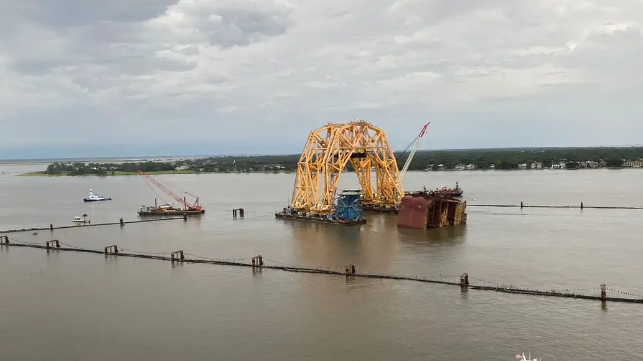Final Section of Wrecked Ro/Ro Golden Ray May Take Time to Remove

Two sections of the hull of the wrecked ro/ro Golden Ray have been loaded out onto a deck barge for transit to a scrapyard, and salvors are now preparing to lift and remove the very last segment from St. Simons Sound, Georgia.
Once the two loaded sections are secured and ready for an ocean transit, the deck barge Julie B will depart the Port of Brunswick to head for a recycling facility in Louisiana. The sections have already been stripped of excess weight, including wrecked cars and loose movable decks.
The final section may take some time to move. Before hoisting, the salvors expect that extra weight-shedding operations may be required. The adjacent section was heavily damaged on the bottom-facing (port) side, and the team had to weld up a custom cradle to support the remaining structure in order to load it on a dry dock barge.
It is expected that the final section will need a similar arrangement. Once it is lifted, the salvage master and the response engineering team will design a cradle system that will hold up the wreckage for a short-distance transit. After hoisting, it will be partially dismantled at a nearby facility in preparation for its final voyage.
The response command's survey teams continue to recover debris from the wreck along shorelines and marsh areas near the wreck site. The large scale oil spills that escaped from the wreck site in August have not recurred, and reports of wildlife oiling have been minimal.
The Golden Ray went aground and partially capsized in Georgia's St. Simons Sound in September 2019, more than two years ago. During an outbound transit in calm conditions, a routine turn to starboard turned into an uncontrolled runaway maneuver, ending with the vessel aground and resting on her side.
Lt. Ian Oviatt, a staff engineer at the Coast Guard Marine Safety Center, told the NTSB that the vessel had taken on too little ballast for her cargo load. “The cause of the vessel capsizing was lack of righting energy due to the way the vessel was loaded,” Oviatt testified before an NTSB panel last September. “The vessel could have taken on additional ballast to be in compliance.” The NTSB's final report on the casualty reflected a similar conclusion.
